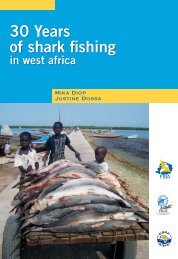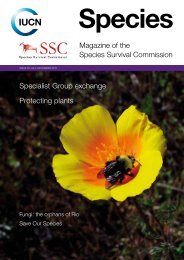Kyne & Simpfendorfer.. - Shark Specialist Group
Kyne & Simpfendorfer.. - Shark Specialist Group
Kyne & Simpfendorfer.. - Shark Specialist Group
Create successful ePaper yourself
Turn your PDF publications into a flip-book with our unique Google optimized e-Paper software.
aborting near-term embryos, with has been observed in this species (Ebert 1986). The<br />
reproductive cycle has been postulated to be least one year (Capapé et al. 2004), but the<br />
precise duration of gestation is unknown, although it is likely to be extended.<br />
Ebert (1986) attempted to use traditional ageing methodologies on vertebral centra to age H.<br />
griseus, but these were unsuccessful. McFarlane et al. (2002) examined the suitability of<br />
using the neural arches to age this species and noted their potential given observed distinct<br />
and regular bands, the number of which increased with total length. However, the authors<br />
emphasized that their work was preliminary and that further research needs to include<br />
validation of their method, in order to determine if bands are laid down annually. Compagno<br />
(in prep. a) notes that the species is probably long-lived.<br />
During a study of the reproductive biology of H. perlo off Kyushu, Japan (Tanaka and Mizue<br />
1977), 218 females were observed, of which only a single gravid female with 11 embryos was<br />
found. The embryos measured an average of 242mm TL and were considered to be near-term.<br />
Bigelow and Schroeder (1948) reported litter sizes of 9–20 from Cuba (including L. Howell-<br />
Rivero, pers. comm. in Bigelow and Schroeder 1948). Tanaka and Mizue (1977) indicate that<br />
the species has no defined reproductive cycle off Japan. Females mature at 950–1050mm TL<br />
off Japan (Tanaka and Mizue 1977), while a 932mm TL female from Cuba was also mature<br />
(Bigelow and Schroeder 1948). With a maximum size of 1390mm TL (a record of 2140mm<br />
TL may be erroneous) (Bigelow and Schroeder 1948, Compagno et al. 2005), female maturity<br />
is reached from 67%TL max .<br />
Hexanchus nakamurai is a very poorly-known species that is reportedly born at 400–430mm<br />
TL; females mature at ~1420mm TL; males mature at ~1230mm TL (Springer and Waller<br />
1969, Compagno in prep. a). A litter size of 13 has been reported for the species (Compagno<br />
in prep. a).<br />
Order Squaliformes. Dogfish <strong>Shark</strong>s.<br />
Squaloid species are yolk-sac viviparous, the majority being lecithotrophic, while a few have<br />
been shown to have limited matrotrophic input (limited histotrophs) (Musick and Ellis 2005).<br />
Guallart and Vicent (2001) confirmed the gulper shark Centrophorus granulosus as strictly<br />
lecithotrophic.<br />
Family Echinorhinidae. Bramble <strong>Shark</strong>s.<br />
Echinorhinid sharks are poorly-known and data on their biology is available only from<br />
incidental observations. Bramble shark Echinorhinus brucus are born at 400–500mm TL with<br />
maturity at 2000–2200mm TL for females and, although uncertain, 2540mm TL and
















